Abstract
Acute myocardial infarction (AMI) is one of the leading causes of morbidity and mortality worldwide, while early diagnosis still represents an upmost priority. While platelet activation is critical for AMI pathogenesis, the role of platelet microRNAs (pmiRNAs) as biomarkers for AMI is unclear. Furthermore, correlations between the levels of pmiRNAs and indices of platelet activity are also unknown. Expression of platelet miR-1, miR-21, miR-126, miR-150 and miR-223 were prospectively assessed in 20 ST-segment elevation myocardial infarction (STEMI) patients, and 40 healthy volunteers. Platelet reactive units (PRU) were assessed with cartridge analyzer, and vasodilator-stimulated phosphoprotein (VASP) was measured by flow cytometry. There were no significant changes in pmiR-1 expression. Expressions of pmiR-21 and pmiR-126 were decreased, while pmiR-150 and pmiR-223 were increased in STEMI patients when compared to controls (all p < 0.01). However, only pmiR-126 exhibited correlation with plasma cardiac troponin I (r = − 0.556, p = 0.011) in STEMI. There was no correlation between pmiRNAs with PRU or VASP during admission, or at 48 h post-stenting. Among tested pmiRNAs, pmiR-126 may serve as a potential novel biomarker for STEMI, while pmiR-1, pmiR-21, pmiR-150, and pmiR-223 were not particularly useful. Moreover, since assessed pmiRNA expression did not correlate well with platelet activity indices their potential diagnostic utility is quite limited.




Similar content being viewed by others
References
White HD, Chew DP (2008) Acute myocardial infarction. The Lancet 372:570–584
Anderson JL, Adams CD, Antman EM et al (2007) ACC/AHA 2007 guidelines for the management of patients with unstable angina/non ST-elevation myocardial infarction: a report of the American College of Cardiology/American Heart Association Task Force on Practice Guidelines (writing committee to revise the 2002 guidelines for the management of patients with unstable angina/non ST-elevation myocardial infarction): developed in collaboration with the American College of Emergency Physicians, the Society for Cardiovascular Angiography and Interventions, and the Society of Thoracic Surgeons: endorsed by the American Association of Cardiovascular and Pulmonary Rehabilitation and the Society for Academic Emergency Medicine. Circulation 116:e148-304
Alpert JS, Thygesen K, Antman E et al (2000) Myocardial Infarction Redefined-A Consensus Document of The Joint European Society of Cardiology/American College of Cardiology Committee for the Redefinition of Myocardial Infarction. J Am Coll Cardiol 36:959–969
Thygesen K, Alpert JS, Jaffe AS et al (2012) Third universal definition of myocardial infarction. J Am Coll Cardiol 60:1581–1598
Keller T, Zeller T, Ojeda F et al (2011) Serial changes in highly sensitive troponin I assay and early diagnosis of myocardial infarction. JAMA 306:2684–2693
Giannitsis E, Katus HA (2013) Cardiac troponin level elevations not related to acute coronary syndromes. Nat Rev Cardiol 10:623–624
Bronze-da-Rocha E (2014) MicroRNAs expression profiles in cardiovascular diseases. Biomed Res Int 2014:985408
Wang F, Long G et al (2013) Plasma microRNA-133a is a new marker for both acute myocardial infarction and underlying coronary artery stenosis. J Transl Med 11:222
Sayed AS, Xia K, Yang TL et al (2013) Circulating microRNAs: a potential role in diagnosis and prognosis of acute myocardial infarction. Dis Markers 35:561–566
Widera C, Gupta SK, Lorenzen JM et al (2011) Diagnostic and prognostic impact of six circulating microRNAs in acute coronary syndrome. J Mol Cell Cardiol 51:872–875
Plé H, Landry P, Landry P et al (2012) The repertoire and features of human platelet microRNAs. PLoS One 7:e50746
McEwen BJ (2015) The influence of herbal medicine on platelet function and coagulation: a narrative review. Semin Thromb Hemost 3:300–314
Thygesen K, Alpert JS, Jaffe AS et al (2012) Third universal definition of myocardial infarction. Circulation 126:2020–2035
Varenhorst C, James S, Erlinge D et al (2009) Assessment of P2Y(12) inhibition with the point-of-care device VerifyNow P2Y12 in patients treated with prasugrel or clopidogrel coadministered with aspirin. Am Heart J 157:562
Bonello L, Tantry US, Marcucci R et al (2010) Consensus and future directions on the definition of high on-treatment platelet reactivity to adenosine diphosphate. J Am Coll Cardiol 56:919–933
Henderson AR (2006) Testing experimental data for univariate normality. Clin Chim Acta 366:112–129
Wileyto EP, Li Y, Chen J, Heitjan DF (2013) Assessing the fit of parametric cure models. Biostatistics 14:340–350
Lee RC, Feinbaum RL, Ambros V et al (1993) Elegans heterochronic gene lin-4 encodes small RNAs with antisense complementarity to lin-14. Cell 75:843–854
Latronico MV, Condorelli G (2009) MicroRNAs and cardiac pathology. Nat Rev Cardiol 6:419–429
Kai ZS, Pasquinelli AE (2010) MicroRNA assassins: factors that regulate the disappearance of miRNAs. Nat Struct Mol Biol 17:5–10
Huang XA, Lin H (2012) The miRNA regulation of stem cells, Wiley interdisciplinary reviews: Wiley. Interdiscip Rev Membr Transp Signal 1:83–95
Thum T, Catalucci D, Bauersachs J (2008) MicroRNAs: novel cardiac development and disease. Cardiovasc Res 79:562–570
Cheng Y, Tan N, Yang J et al (2010) A translational study of circulating cell-free microRNA-1 in acute myocardial infarction. Clin Sci (Lond) 119:87–95
Long G, Wang F, Duan Q et al (2012) Human circulating microRNA-1 and microRNA-126 as potential novel indicators for acute myocardial infarction. Int J Biol Sci 8:811–818
Oerlemans MI, Mosterd A, Dekker MS et al (2012) Early assessment of acute coronary syndromes in the emergency department: the potential diagnostic value of circulating microRNAs. EMBO Mol Med 4:1176–1185
Devaux Y, Vausort M, McCann GP et al (2013) MicroRNA-150: a novel marker of left ventricular remodeling after acute myocardial infarction. Circ Cardiovasc Genet 6:290–298
Cimmino G, Tarallo R, Nassa G et al (2015) Activating stimuli induce platelet microRNA modulation and proteome reorganisation. Thromb Haemost 23:114
Weyrich AS, Lindemann S, Tolley ND et al (2004) Change in protein phenotype without a nucleus: translational control in platelets. Semin Thromb Hemost 30:491–498
Marcucci R, Gori AM, Paniccia R et al (2009) Cardiovascular death and nonfatal myocardial infarction in acute coronary syndrome patients receiving coronary stenting are predicted by residual platelet reactivity to ADP detected by a point-of-care assay: a 12-month follow-up. Circulation 119:237–242
Meadows TA, Bhatt DL (2007) Clinical aspects of platelet inhibitor and thrombus formation. Circ Res 100:1261–1275
Shi R, Ge L, Zhou X et al (2013) Decreased platelet miR-223 expression is associated with high on-clopidogrel platelet reactivity. Thromb Res 131:508–513
Acknowledgements
This research was supported by the National Research Foundation of Korea (NRF) funded by the Korea government (MSIP) (2015R1C1A2A01052751). Part of this work was supported by the “Brain Pool” program funded by the Korea Ministry of Science and Technology to Dr. Serebruany.
Author information
Authors and Affiliations
Corresponding author
Ethics declarations
Conflict of interest
The authors declare no conflicts of interest.
Ethical approval
All procedures performed in studies involving human participants were in accordance with the ethical standards of the institutional and/or national research committee and with the 1964 Helsinki declaration and its later amendments or comparable ethical standards.
Informed consent
Informed consent was obtained from all individual participants included in the study.
Rights and permissions
About this article
Cite this article
Li, S., Guo, L.Z., Kim, M.H. et al. Platelet microRNA for predicting acute myocardial infarction. J Thromb Thrombolysis 44, 556–564 (2017). https://doi.org/10.1007/s11239-017-1537-6
Published:
Issue Date:
DOI: https://doi.org/10.1007/s11239-017-1537-6




